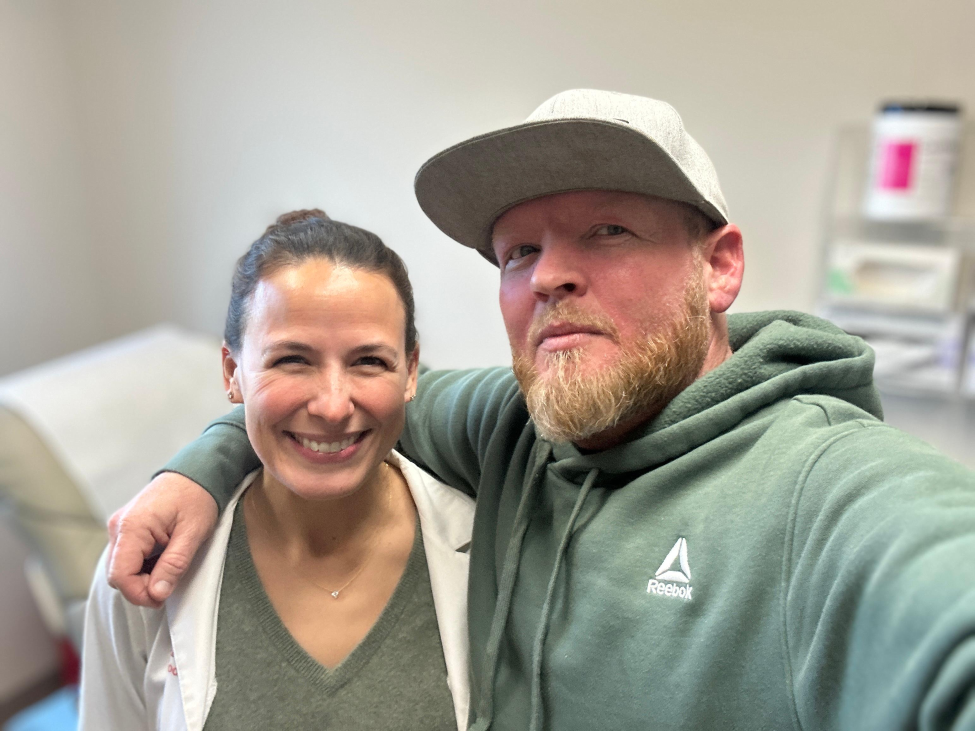At the Bedside: Seconds away from death, heart attack patient decides to fight, survives with help from UTHealth Houston cardiologist


That Thursday morning in January started like any other as Christopher Blankenship, 47, headed into work feeling just fine. However, just a few hours into his eight-hour shift, he felt a slight discomfort between his shoulder blades. He shrugged the pain off, thinking it was a random twinge from a previous accident. But the pain intensified, and Christopher told his co-worker he needed to take a break and sit in his car.
“I walked to the parking lot, sat down in my car and was holding on to my car steering wheel, trying to stretch out my shoulder blades when I started to get dizzy,” Christopher said. “I stepped out of my car to get some air, and the next thing I remember, I was waking up on the ground next to my car.”
He didn’t know it, but a silent buildup in one of the arteries of Christopher’s heart was rupturing, and the result was a heart attack. He knew he needed help fast. He was able to gather his last bit of strength, pull himself back into his car, and call for the on-site medical team before he fell unconscious again. The team arrived, immediately began life-saving measures, and called an ambulance to get him to the nearest hospital. In flashes of consciousness, Christopher found himself in a different reality every time he woke up again.
“I was in the ambulance, and paramedics were telling me to stay awake and that I would be okay, but all I remember thinking is, ‘How did I get here?’” Christopher said. “The pain felt like a golf ball in my chest, and I could not handle it; that is when the paramedic yelled to the driver, ‘He is not going to make it, we need Life Flight.’”
The electrocardiogram performed in the ambulance revealed arrhythmias – irregular heartbeats – and paramedics decided Christopher needed faster intervention if he was going to live. They pulled the ambulance to a safe location and waited for Memorial Hermann’s air ambulance, Life Flight. In and out of consciousness, Christopher heard the air medic’s voice telling him everything would be okay and to stay awake, but Christopher described that voice sounding further and further away.
“It is like I was disconnected from his voice and disconnected from my surroundings; this is when I knew I was about to pass away,” he said. “I stopped hurting, I just existed, it just felt so peaceful, and it was like I could hear myself talking and telling me, ‘The choice is yours; you can fight, or you can let go, and either choice was completely okay.’ At that point, I chose to fight, and all of a sudden, it was like I was going 1,000 miles per hour and straight back into chaos.”
His near-death experience that day changed the course of his life for the better, and he said he owes it all to on-site physicians where he works, ambulance paramedics, Life Flight paramedics, and a UTHealth Houston cardiologist.
The Life Flight staff called the hospital ahead of time and alerted the cardiologist on duty in the Emergency Center at Memorial Hermann-Texas Medical Center. Brittany Owen, MD, an assistant professor of cardiovascular medicine at McGovern Medical School at UTHealth Houston and an interventional cardiologist at UT Physicians and UTHealth Houston Heart & Vascular, as well as an attending physician at Memorial Hermann-TMC, answered the call that day. She prepped the catheter lab and prepared the staff so that when the team landed, she could immediately go to work to save Christopher’s life.
When he arrived, his blood pressure was extremely low, and his heart rate was completely unstable. Intravenous fluid and vasopressors, a group of medicines that tighten blood vessels and raise blood pressure, kept Christopher alive. Owen had to work faster than the spreading damage of the rupture in Christopher’s heart to save him. She got him into an operating room and performed a coronary angioplasty, a procedure where a tiny balloon on a narrow tube, called a catheter, is used to widen a clogged artery and improve blood flow. Then, she placed a small wire mesh tube, called a stent, into the artery; the stent helps prop the artery open and decreases the chance of the artery narrowing again.
“Because his blood pressure and heart rate were so low, I could not put him under anesthesia; I could only give a local anesthetic, so he was awake during the procedure. As soon as you open the artery, a lot of those things get better, but until then, it is a constant battle of keeping him alive,” Owen said.
Once the procedure was finished, she determined he had other clogged arteries that were going to need a stent placement as well. While some factors like diet had a small impact, Owen said years of smoking were the reason for Christopher’s heart attack, and if he continued smoking, the stents would fail, and he could have another heart attack. A few weeks after his first procedure, Christopher underwent a second stent placement and has attended cardiac rehabilitation to make sure his heart is continuing strong. He has not smoked since the day he almost died.
“I got a second chance at life because of God, Dr. Owen, and many others, and I cannot take that for granted again,” he said.